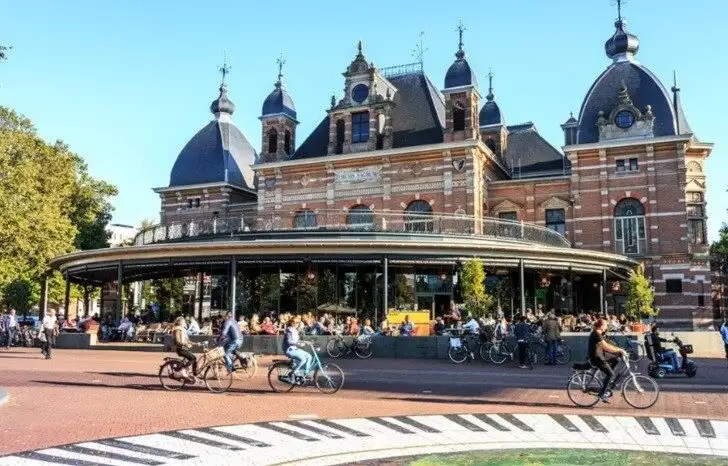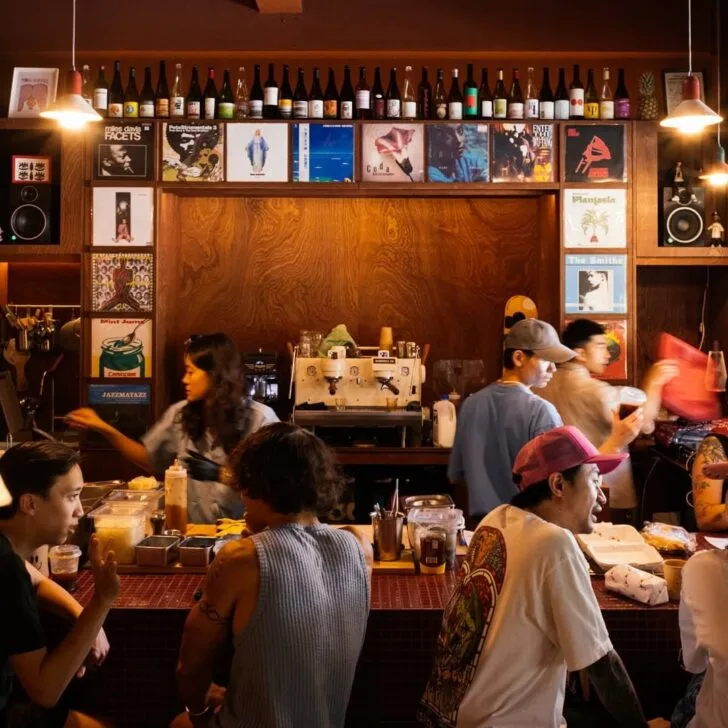We may receive a commission if you make purchases through affiliate links (at no extra cost to you). Read why our approach to travel is different.
There’s a lot to be said for first impressions. I’m regularly guilty of judging a book by its cover, but in Georgia’s case, I can safely say I was right. Gazing out of the window on a flight from Baku to Tbilisi, my first views of Georgia made me instantly fall in love with the country before I’d even set foot in it.
A few days of Georgian hospitality, some of the world’s best food and discovering loads of fascinating, albeit rather dark, history, Georgia became my favorite country in the world. It still is.
Over the last decade, Georgia has become ever popular, popping up on the radars of travelers who had never considered it as a destination before. It’s no surprise: Georgia is beautiful, welcoming and full of hidden treasures. To help you make the most of your visit to Georgia, we’ve put together the ultimate 5 day Georgia itinerary.

Skip to...
Where is Georgia?
Despite its rapid growth in popularity, there are still plenty of people, including seasoned travelers, who aren’t 100% sure where Georgia is located. One thing is for sure: it’s not in the United States of America. This Georgia’s capital is Tbilisi, not Atlanta, and as great as ‘The Peach State’ is, this one is better!
Georgia is in the South Caucasus region at the meeting point of Europe and Asia. It’s bordered by Russia to the north, Azerbaijan in the east and Türkiye and Armenia to the south, whilst the west of Georgia sits on the Black Sea, stretching 700 miles towards Bulgaria.
Is Georgia safe to visit?
Given the location and the ongoing war between Russia and Ukraine, you might be wondering if Georgia and the Caucasus are safe. The simple answer is a resounding yes. Crime levels across the country are low (far lower than the United Kingdom or United States) and the political situation is stable.



Can I travel to South Ossetia or Abkhazia?
Most Western governments advise against travel to South Ossetia and Abkhazia. These are breakaway separatist regions of Georgia which claim allegiance to Russia. Therefore, we don’t include these areas in our 5 day Georgia itinerary.
How to get to Georgia
If you’re only visiting Georgia on this trip, or it’s your first stop on a Caucasus adventure, the chances are you’ll arrive by air. Georgia has three main airports: Tbilisi (TBS), Batumi (BUS) and Kutaisi (KUT).

Tbilisi, as the capital city, sees the most international flights. Regular, year-round flights operate to cities across Europe, Central Asia, the Middle East and Russia.
Kutaisi Airport (Airport code: KUT) has established itself as a low-cost hub, with cheap direct flights available to a number of European destinations including Berlin, Milan, Rome, Warsaw and more. You can also fly directly to several cities in Kazakhstan and Russia.
Batumi Airport (Airport code: BUS) sees mainly seasonal flights during the summer, but a few year-round services exist to Baku, Istanbul and Moscow.
Many travelers choose to combine a trip to Georgia with visits to Azerbaijan and Armenia. This is a great way to tick off three countries at once. More excitingly, as you cross borders you’ll experience three extremely unique cultures and national identities in a relatively compact region. If you are considering this, don’t miss our insights for traveling in Azerbaijan and Armenia.
Getting around Georgia

Whilst hiring a car gives you the flexibility to go wherever, whenever, public transport in Georgia is excellent.
All locations included in this itinerary are easily accessible by public transport.
Georgian Railways operates a fleet of modern trains which serve most major towns and cities. You can check times and book tickets on their website, or user-friendly mobile app, both of which are available in English. Intercity buses are also available to a number of destinations. Alternatively, you can take the cheaper, but less comfortable marshrutkas (minibuses) which generally leave when they fill up.

Within cities, buses and taxis are readily available, with ride-sharing apps including Bolt, Yandex and Maxim being popular options (Uber is not currently available in Georgia). The Tbilisi metro operates two lines covering 23 stations at a flat fare of 1 Georgian Lari (GEL) for every journey (around US$0.40).
Local tip: In Tbilisi, it’s worth purchasing a Travel Card which offers up to 20 rides per day on the Metro, buses, mini buses and cable cars (excluding the Narikala Ropeway).
Travel Cards are valid for either one day (3 GEL) or one week (20 GEL) with longer term options available for longer stays. The one-day option tends to work out cheaper unless you’re staying for seven days and plan to make multiple trips each day. Travel cards can be purchased from ticket offices at any Metro station or Bank of Georgia Express branches.

The Ultimate 5 Day Georgia itinerary
This itinerary is based upon starting in Tbilisi as the main gateway to Georgia, but it works just as well in reverse (i.e., starting in Batumi). If arriving at Kutaisi Airport, the easiest path to follow it is to start in Kutaisi, then head to Batumi to work your way back to Tbilisi (skipping Kutaisi, unless you want to go back for more).
Many travelers start and end their trip in Tbilisi, if you’re considering this option you’ll want to read our guide to the best day trips from Tbilisi.
Days 1 & 2: Tbilisi
Set in a dramatic valley on the banks on the Mtkvari River, Georgia’s colorful, vibrant capital is by far the most cosmopolitan and international city in the Caucasus. With a historic old town, scenic hilltop parks, a world-class food scene and buzzing nightlife, Tbilisi will be a highlight of any trip to Georgia.



Getting from Tbilisi Airport to your hotel
For those coming by air, Shota Rustaveli Tbilisi International Airport is 11 miles from the city center.
By bus
The cheapest way to reach the city is by bus. Line 37 runs between the Airport and Tbilisi railway station via Freedom Square, taking around 45 minutes. Buses run 24/7 and a one-way fare costs 0.5 GEL.
By car
Taxis are readily available outside the terminal and a one-way ride should cost around 25 GEL. If you’re coming off a long flight and don’t want to deal with the hassle, prebook a transfer to save you time and energy.
By train
There is a train station at Tbilisi Airport, but there are only two or three trains a day. In short, the train is unlikely to be a good option.

Where to stay in Tbilisi
There’s no shortage of hotels, with options available for any budget or preference. We’d recommend staying in, or on the edges of, the Old Town. Some of the best boutique options are Shota@Rustaveli Boutique Hotel, Aqua Liberty Hotel and Tbilisee Hotel.
If you’re looking for 5-star luxury, The Biltmore and Monograph Freedom Square are great options. For a more wallet friendly place to stay, consider Hotel Isaka or Hotel Piano.
Where to eat in Tbilisi
The Georgians say “every meal in Georgia is a feast” – and they really mean it.
Georgian cuisine is among the best in the world, yet for some reason it is little known outside of the country. Every visitor to Georgia should be familiar with Georgia’s two most famous dishes: khachapuri, a boat-shaped bread often filled with egg, cheese and a lot of butter and khinkali which are hearty meat filled dumplings. You’ll find grilled and smoked meat and stews on almost every menu, with walnuts are a staple ingredient in many dishes.

One of the most iconic restaurants in Tbilisi is Old Metekhi (Metekhi Rise, Tbilisi) which sits high above the river in the hotel of the same name. You’ll find all the Georgian staples along with Georgian wine (among the world’s finest).
A great spot during the summer is Sofia Melnikovas Fantastiuri Duqani (Stamba Dead End, Tbilisi), a hidden garden restaurant known for their khinkali. For an extra special meal, head to Poliphonia, a traditional Georgian restaurant designed to appear as a cave. On top of all the Georgian classics, Poliphonia has an extensive plant-based menu as well.
There’s one last spot which you really can’t miss whilst in Tbilisi: Mtatsminda in Mtatsminda Park. Reached by funicular railway (or a very long uphill walk), this spot offers hands down the best views of the city.

If you’re keen to learn more about Georgian cuisine, one of the top things to do in Tbilisi is attend a cooking class. The question is whether you really want to know how much butter goes into khachapuri…
What to see and do in Tbilisi
If you hadn’t already guessed, Mtatsminda Park is going to be right at the top of the list of must-sees in Tbilisi. You can reach the park by a three-minute funicular ride which leaves from the Old Town. The funicular runs every ten minutes from 9 am to 10.30 pm (with a later train down for restaurant guests only).
You can purchase tickets from machines or booths at the station for 8 GEL, plus 2 GEL for a reloadable card which you can also use for attractions in the park.
Aside from the restaurant and the views, Mtatsminda Park is also an amusement park with everything from a Ferris wheel and bumper cars to a rollercoaster and log flume.

Another top Tbilisi attraction which involves reaching the top of a hill is Narikala Fortress. An aerial tramway runs from beside the Peace Bridge (new town side), taking five minutes to reach the top, with prices from 2.5 GEL one-way with a Travel Card.
Narikala Fortress was built in 364 AD for King Varaz Bakur, although much of what remains today dates from the 16th & 17th century. Inside the fortress, the Church of St Nicholas was rebuilt in the 1990s and is an impressive sight.

Tbilisi’s sulphur baths
Back on terra firma, visiting the Sulphur Baths in Old Tbilisi is one of the ultimate Georgia experiences. Tbilisi only exists where it does due to the natural hot springs which run underneath the city. It was these hot springs that gave Tbilisi its name, which means ‘warm place’ in Georgian.
Local tip: The best place to experience Tbilisi’s sulphur baths is in the Abanotubani District.
Abanotubani District is at the edge of the OId Town on the southside of the river. Just down a passageway beside the Mercure Hotel, you’ll find a boardwalk leading to a gorge formed by the hot springs.

If you fancy pampering yourself with a visit to a Georgia bathhouse, there are dozens to choose from. Public baths are the cheapest option (around 15 GEL for an hour) and offer a traditional experience.
Public bathhouses may be cheapest, but they come with the caveat that you have to get naked in front of a bunch of strangers.
If that doesn’t sound like your thing, private baths are also available at a heftier price tag, with the cheapest costing around 70 GEL (US$26) per hour whilst the most luxurious will set you back 500 GEL (US$188). Gulo’s Thermal Baths is a good option for private rooms which won’t break the bank.
Leaving Tbilisi
Tbilisi is a city you couldn’t bore of in a lifetime, but sadly with just 5 days in Georgia, it’s time to move on. Of course, if you have the luxury of more time, it is definitely worth staying in Tbilisi for a few more days. Alternatively, many travelers stay in Tbilisi for their entire 5 days in Georgia, opting to use the city as their base for day trips. If you’re considering this option, don’t miss our guide to the best day trips from Tbilisi (and how to do them).

Day 3: Gori
For both history and nature buffs, Gori is often a highlight of Georgia. This small, unassuming city may seem a bit rough around the edges, but it holds some of Georgia’s most fascinating history. It’s not only Georgian history that Gori has played a role in, but the world’s.

Getting to Gori
If you’ve rented a car, the drive to Gori is an easy one; it’s around an hour straight along the highway. If traveling by public transport, the quickest and most comfortable option is to take the train. There are currently three trains per day between Tbilisi and Gori: two in the morning and one late afternoon. The journey takes between 55 and 75 minutes, with tickets starting at 8 GEL.
Minibuses also run from Tbilisi to Gori, departing every hour from Didube Bus Terminal. Fares are around 6 GEL, payable onboard by card only.
Where to stay in Gori
In recent years, a few decent accommodation options have opened up in Gori, with everything from budget guesthouses to international standard hotels.

Georgia Gold is my top pick, with a pool and restaurant on site and very reasonable rates (expect to pay around 180 GEL/US$70). Gori Apartments is a great self-catering option in the centre of town, and Anna’s Guest House is an excellent budget-friendly choice (from 100 GEL/ US$39).
Where to eat in Gori
There’s nowhere in Georgia you’ll struggle to find a good meal, and Gori is no exception. KE&RA (Moskov Street 2) is the top spot for healthy, home-cooked meal in hip surroundings. Black Stars (Besarion Jugashvili Street 13) is another great option for classic Georgian cuisine. For cheap eats with a menu featuring hearty khachapuri and juicy burgers, try L’Avenue (Stalini Avenue 24).
What to see and do in Gori
Gori’s main claim to fame is as the birthplace of Joseph Stalin, the second General Secretary of the Soviet Union from 1922 until his death in 1954. Stalin was born in Gori in December 1878 before moving to Tbilisi in 1894 to enrol in the Russian Orthodox Seminary.

Stalin’s childhood home is now a museum and is the one must-see attraction in Gori. The museum is open every day from 10 am until 5 pm. Tickets cost 15 GEL (guided tour) or 10 GEL (no tour).

Travel tip: The 15 GEL guided tour ticket is the same price as a standard admission ticket plus the fee to visit Stalin’s carriage, so we always recommend taking a guided tour!
Gori Fortress sits in an imposing position overlooking the city. It was built in the 13th century but was significantly damaged in an earthquake in 1920 and has since been partially rebuilt. The view from the hilltop is amazing and budget travelers will be pleased to know that entrance is free.

Leaving Gori
I recommend leaving Gori in the afternoon of Day 3 if you’re driving, or the following morning if traveling by train. There’s only one train per day to your next stop, Kutaisi, which leaves at around 10 am. The journey takes just over four hours, with tickets starting at 8 GEL.
Day 4: Kutaisi
Imposing architecture and fascinating museums make Georgia’s third city well worthy of a visit. The capital of the Abkhazia during the Middle Ages, then the Kingdom of Georgia until as late as 1810, little-known Kutaisi was once a major powerhouse.

Where to stay in Kutaisi
Thanks in part to the recent development of Kutaisi Airport, there’s a massive choice of hotels in Kutaisi. Hotel History is my favorite. It’s exceptionally good value, offering boutique rooms for just 130 GEL (US$50). Other top picks include Hotel Terrace, Newport Hotel and Communal Hotel Kutaisi. If you prefer small guesthouses, Four Seasons in Kutaisi is an absolute gem, even if it isn’t quite a Four Seasons.
Where to eat in Kutaisi
If you’re reading this before sampling Georgian food, you might think you’ll be ready for something a bit different by this point in the trip. I promise you won’t. In fact, if you’re anything like me, the first thing you’ll do when you get home is buy a Georgian cookbook.
Toma’s Wine Cellar (Sergo Kldiashvili 34) is our top pick in Kutaisi, serving all the classics with, as the name suggests, an exceptional wine list. Our Garden (Bagrati Street 23) is a beautiful spot to eat on a sunny day and Caffe El Paso (2 Agmashenebeli Street) is great for cheap eats.
What to see and do in Kutaisi
Bagrati Cathedral is Kutaisi’s most beautiful building. Built in 1033 by King Bagrat III (hence the name), the cathedral been extensively restored in recent years following a canon attack by Ottoman soldiers in 1692. It was further damaged in 1769 during the Georgian-Russo-Turkish wars. Since 1994, the cathedral has been a UNESCO World Heritage Site.

Local tip: 8 km outside of Kutaisi, Gelati Monastery is another key religious site. Built in 1106, today the Monastery is a part of the UNESCO site along with Bagrati Cathedral.
Just to the east of Bagrati Cathedral you’ll find the ruins of the palace-citadel from the 6th century. It’s laid in ruin since 1769 but part of the walls and remnants of the church and wine cellars can still be seen.
Kutaisi Historical Museum is a fascinating place to spend a couple of hours. It houses exhibits from all around Georgia. The highlight is an icon from Bagrati Cathedral which purportedly is capable of performing miracles.

As a final stop, pay a visit to Kutaisi Indoor Market. This lively, colorful market is always busy and sells all the staple ingredients needed to cook up a good Georgian meal. Try some churchkhela: strings of walnuts covered in grape-juice caramel. An unusual sounding combination, but a tasty one.
Leaving Kutaisi
You can either leave Kutaisi in the afternoon of Day 4 or, the better option if traveling by train, on the morning of Day 5. Your final stop, 150 km to the west, is Georgia’s second city: Batumi.
Day 5: Batumi
Batumi is Georgia’s seaside playground and is both a lively yet subdued city. The bustling corniche is a hive of activity, whilst the quaint Old Town is a historical time warp. Whichever way you look in Batumi, your eyes will be filled with beauty, be it the Black Sea or the snow-capped peaks behind the city.

Getting to Batumi
By train
Kutaisi and Batumi are very well connected by public transport. Two trains operate between the two cities every day, with one early in the morning and one late afternoon. The journey takes just over four hours, and tickets start from 7 GEL.
By minibus
Minibuses also run from Kutaisi, with prices from 8 GEL. The journey takes around two and a half hours, with departures every hour, making this the quickest option albeit slightly less comfortable than the train.
Where to stay in Batumi
As a popular holiday destination for Georgians and foreigners, you’re spoiled for choice with hotels in Batumi. International brands including Hilton, Le Meridien, Courtyard by Marriott, Ramada Plaza, Radisson Blu and Wyndham all have properties here.

Independent boutique hotels tend to offer better value and a more quirky experience. Blue Star Batumi is my top pick and occupies a very unusual looking building! Boulevard Hotel is a great choice if you want to be close to the beach. For a budget-friendly option, look no further than Guest House Batumi Globus where rooms start from 88 GEL (US$33).
Where to eat in Batumi
As a tourist hotspot, Batumi has restaurants catering to pretty much any taste imaginable. If you decide to stray away from Georgian food, opting for one of Batumi’s many Turkish restaurants is a good idea. Liman Restaurant (Gogebashvili 3) is a great place for kebabs and corbalar. Russian restaurant Guests (Melashvili 16), whose owner hails from St Petersburg, is a Batumi institution. If you go, try their Chicken Pelmeni.
If you stick with Georgian cuisine, Old Boulevard (Vazha Pshavela 5) is one of Batumi’s best. While Cafe Retro (Takaishvili 10) is the place to go for khachapuri in Batumi.
What to see and do in Batumi
The beach is Batumi’s main attraction and is a great place to relax at the end of your jam-packed 5 day Georgia itinerary. Beachside restaurants and bars are lively and a hub of activity all year round and stretch all the way along the 7km long Boulevard.

From just behind the Corniche, a cable car climbs 2.6 kilometers above the city to Anuria Hill, offering the best views of the city. You’ll find a restaurant and shopping complex at the top station, making this a lovely place to meander in the afternoon. Tickets can be purchased online or at the station and cost 30 GEL round trip.
Local tip: Taxi drivers and touts have been known to sell fake, rip-off tickets for the cable car. Only purchase tickets from the official website or ticket office.

Away from the beach, Batumi Old Town is a fascinating place to explore. Here, you’ll find the Ortajame Mosque, which is the only surviving mosque in Batumi and dates back to 1860. Batumi Archaeological Museum showcases exhibits including 1.8 million year old remains, Bronze Age daggers and Byzantine gold. The museum is open daily from 10 am to 6 pm and admission costs 6 GEL.
Alongside classic architecture from yesteryear, Batumi is also the face of modern Georgia. It’s worth taking some time to explore Batumi’s contemporary architecture, including many of Georgia’s newest buildings.
Batumi Tower, the tallest building in the country, has a Ferris wheel built in to the side. Another modern, and increasingly iconic, addition to the city is the Medea Monument. This unique structure depicts local princess Medea who helped her husband Jason obtain a golden fleece.

Staying for a few more days?
Although our 5 day Georgia itinerary gives you the opportunity to see some of the country’s best sights, to fully experience Georgia you’d need a few months!
If time permits, or you reach Batumi and can’t bring yourself to leave, there’s plenty more to see after you’ve recharged your batteries on the beach. Alternatively, stay a few extra days in Tbilisi – the ideal base for some excellent day trips around Georgia. Head high up into the Caucasus mountains to Kazbegi, home to one of the most photogenic churches in the world. Or go south to Vardzia, a cave monastery town whose beauty rivals Cappadocia in Türkiye. Visit the spa town of Borjomi whose water is sold all across Eastern Europe. Go to the historic mining town of Chiatura, stopping off at imposing Katskhi Pilar on the way.
Whatever you choose to do, it’ll be amazing, because it’s Georgia, and Georgia is amazing.

Share This Article

Traveling soon? Subscribe to The Insight below and get exclusive access to our personalized travel advice community via WhatsApp so you can ask all your burning travel questions.
Looking for the best comprehensive travel insurance? SafetyWing has you covered.
And for your eSIM in every country, there is only one option we recommend: Airalo.
Read more of our best insights from around the world





